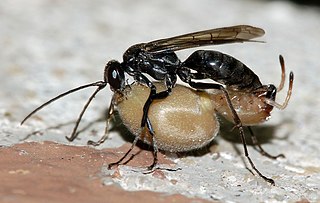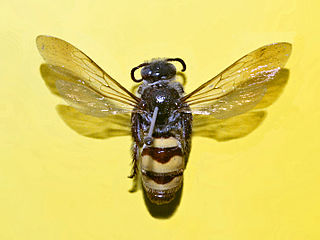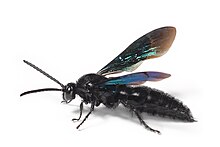
The Scoliidae, the scoliid wasps, are a family of wasps comprising about 560 species worldwide. They tend to be black, often marked with yellow or orange, and their wing tips are distinctively corrugated. Males are more slender and elongated than females, with significantly longer antennae, but the sexual dimorphism is not as apparent as in many of the Tiphiidae and Thynnidae.

Polistes is a cosmopolitan genus of paper wasps and the only genus in the tribe Polistini. Vernacular names for the genus include umbrella wasps, coined by Walter Ebeling in 1975 to distinguish it from other types of paper wasp, in reference to the form of their nests, and umbrella paper wasps. Polistes is the single largest genus within the family Vespidae, with over 200 recognized species. Their innate preferences for nest-building sites leads them to commonly build nests on human habitation, where they can be very unwelcome; although generally not aggressive, they can be provoked into defending their nests. All species are predatory, and they may consume large numbers of caterpillars, in which respect they are generally considered beneficial.
Nesodynerus is a genus of potter wasps endemic to the Hawaiian archipelago. This genus is surprisingly large for the small territory it covers. The genera Chelodynerus and Pseudopterocheilus are presently treated as synonyms of Nesodynerus.

Megascolia procer, the giant scoliid wasp, is a solitary wasp in the family Scoliidae found across Asia. It is one of the largest wasps in the world, with a wingspan of 11.6 cm (4.6 in).
Knemodynerus is a genus of potter wasps distributed through the Palearctic, Afrotropical, Indomalayan and Australasian regions. The species currently classified in the genus are:

Austroscolia soror is a species of scoliid wasp and a common insect found in eastern Australia. This is one of several Australian species collectively referred to as a blue flower wasp, black flower wasp, or blue hairy flower wasp.

Auplopus is a large genus of spider wasps belonging to the subfamily Pepsinae of the spider wasp family Pompilidae, distributed throughout the world except for Antarctica. Auplopus wasps amputate the legs of their spider prey before transporting it to the nest.

Campsomeriella is a genus of the family Scoliidae, also known as the scoliid wasps. They are generally parasites of beetle larvae, most often of Scarabaeidae.

Scolia is a genus of scoliid wasps in the subfamily Scoliinae. There are over 200 described species in Scolia.

Campsomeris is a Neotropical genus of the family Scoliidae, also known as the scoliid wasps. They are generally parasites of beetle larvae, most often of Scarabaeidae.

Dielis trifasciata, also known as the three-banded scoliid wasp, is a species in the family Scoliidae.

Scolia nobilitata, also known as the noble scoliid wasp, is a species of scoliid wasp in the family Scoliidae.

Dielis is a New World genus of the family Scoliidae, also known as the scoliid wasps, formerly treated as a subgenus within Campsomeris.

Pygodasis is a New World genus of wasps in the family Scoliidae, formerly treated as a subgenus within Campsomeris.

Xanthocampsomeris is a New World genus of the family Scoliidae, also known as the scoliid wasps, formerly treated as a subgenus within Campsomeris.

Campsomerini is a cosmopolitan tribe of the family Scoliidae. An older, alternative representation of this group is as a subfamily, Campsomerinae.

Scoliini is a cosmopolitan tribe of the family Scoliidae.

Dielis plumipes, the feather-legged scoliid wasp, is a species of scoliid wasp in the family Scoliidae.

Dielis pilipes, the hairy-footed scoliid wasp, is a species of scoliid wasp in the family Scoliidae.














